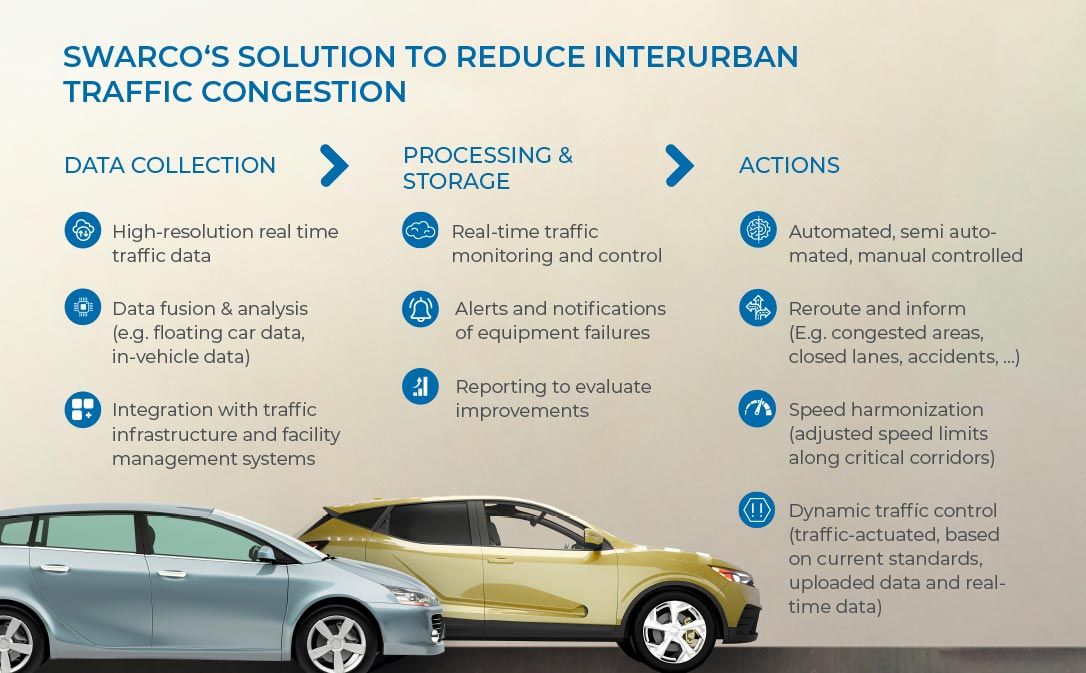Let the Traffic Flow
All drivers know the annoyance of having to drive in congested areas – stop-and-go driving, lost time, getting late to work, dangerous situations, impolite road users, increased pollution, loud surroundings and much more. SWARCO offers an advanced eco-system of mobility that combines and integrates all types of traffic data to enable efficient measures to be taken to significantly reduce traffic congestion in interurban areas. City drivers will be thankful
The Challenge
- In 2018, there were more than 1,528,000 km of road congestions and 457,000 congestion hours on German motorways.
- Each hour lost is equivalent to about 15 euros of unnecessary social costs that add up to multiple millions of euros per year.
- Congestion can occur due to accidents, vehicle breakdowns, road works, etc.
- Road authority policies are becoming more complex due to the continuously changing state of traffic throughout the day and night.
The need to optimze space for our future
- Building more roads will lead to more traffic.
- Each year more than 3 million cars are added to the existing car fleet in Europe alone.
- Over 50% of freight transport takes place on roads.
- Efficient and functioning freight-transport systems are important for businesses and citizens.
- The average annual distance traveled by car is about 11,300 km.

The SWARCO solution
Collect data.
The first step to solve the problem of traffic congestion in interurban areas starts with data
collection. SWARCO’s eco-system of mobility with deep integration of all types of data sources
allows cross-domain applications to be connected and integrated. Infrastructure and mobility
management systems can now be combined with high-resolution, real-time traffic data,
floating car data, apps, 3rd-party data in addition to parking data and more.
Data storage, processing and analysis.
The data collected from integrated devices is sent to SWARCO’s mobility management system
where it is stored, processed, and analysed. The data is visualised in real-time and offers
different reports to provide a holistic overview of what is actually taking place on highways, in
tunnels, and in the city. This helps city traffic managers to reduce traffic congestion and plan
future investments. The system also includes real-time alerts of equipment failure and
incident management.
Measure to reduce traffic congestion.
Once an overview of actual traffic conditions is available, a number of automated, scheduled
or manual actions can be initiated to ease traffic congestion. For example, the speed limit can
be adjusted to enable an optimised traffic flow along critical corridors; traffic can be re-routed
from congested areas; traffic signal controls can be changed to maximize traffic throughput
and reduce traffic jams; and warnings can be issued about upcoming road works.
Alternatively, manual actions can be performed as and when they are needed, such as in
response to an accident.
See the results for yourself.
The continuous feedback from SWARCO‘s mobility management system means that the
results of traffic control measures can be seen in real-time and evaluated to assure that the
employed measures are doing what they are supposed to do: improve traffic flows through
your road and streets and reduce congestion.
Holistic Urban Mobility Management by SWARCO
GET IN TOUCH!
Would you like to further develop your urban mobility management, increase efficiency and make cities more liveable for everyone? Whether it's about fundamental questions or a specific project, whether you want an informative meeting or a demo, we are at your disposal with our know-how. Just fill out the form below and we will get back to you promptly.